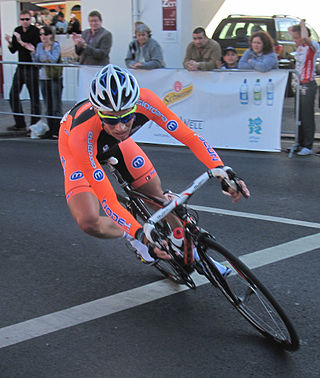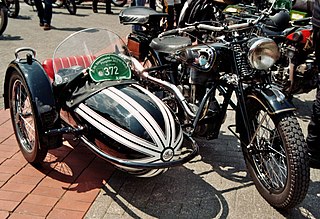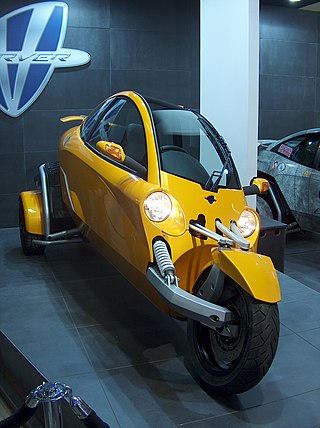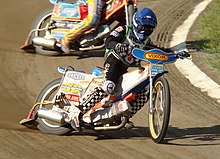
A motorcycle is a two or three-wheeled motor vehicle steered by a handlebar from a saddle-style seat.

A tricycle, sometimes abbreviated to trike, is a human-powered three-wheeled vehicle.

Steering is the control of the direction of locomotion or the components that enable its control. Steering is achieved through various arrangements, among them ailerons for airplanes, rudders for boats, tilting rotors for helicopters, and many more.

A sidecar is a one-wheeled device attached to the side of a motorcycle, scooter, or bicycle, making the whole a three-wheeled vehicle. A motorcycle with a sidecar is sometimes called a combination, an outfit, a rig or a hack.

A single-track vehicle is a vehicle that leaves a single ground track as it moves forward. Single-track vehicles usually have little or no lateral stability when stationary but develop it when moving forward or controlled. In the case of wheeled vehicles, the front and rear wheel usually follow slightly different paths when turning or when out of alignment.

A highsider or high-side is a type of motorcycle accident characterized by sudden and violent rotation of the bike around its longitudinal axis. This generally happens when the rear wheel loses traction, skids, and then suddenly regains traction, causing the rider to be thrown head-first from the side of the motorcycle or over the handlebars.

The lowsider or lowside is a type of motorcycle or bicycle crash usually occurring in a turn. It is caused when either the front or rear wheel slides out as a result of either too much braking into the corner, too much acceleration through or out of the corner, or too much speed carried into or through the corner for the available grip. It may also be caused by unexpected slippery or loose material on the road surface.

The caster angle or castor angle is the angular displacement of the steering axis from the vertical axis of a steered wheel in a car, motorcycle, bicycle, other vehicle or a vessel, as seen from the side of the vehicle. The steering axis in a car with dual ball joint suspension is an imaginary line that runs through the center of the upper ball joint to the center of the lower ball joint, or through the center of the kingpin for vehicles having a kingpin.
Wobble, shimmy, tank-slapper, speed wobble, and even death wobble are all words and phrases used to describe a quick (4–10 Hz) oscillation of primarily just the steerable wheel(s) of a vehicle. Initially, the rest of the vehicle remains mostly unaffected, until translated into a vehicle yaw oscillation of increasing amplitude producing loss of control. Vehicles that can experience this oscillation include motorcycles and bicycles, skateboards, and, in theory, any vehicle with a single steering pivot point and a sufficient amount of freedom of the steered wheel, including that which exists on some light aircraft with tricycle gear where instability can occur at speeds of less than 80 km/h (50 mph); this does not include most automobiles. The initial instability occurs mostly at high speed and is similar to that experienced by shopping cart wheels and aircraft landing gear.

A tilting three-wheeler, tilting trike, leaning trike, or even just tilter, is a three-wheeled vehicle and usually a narrow-track vehicle whose body and or wheels tilt in the direction of a turn. Such vehicles can corner without rolling over despite having a narrow axle track because they can balance some or all of the roll moment caused by centripetal acceleration with an opposite roll moment caused by gravity, as bicycles and motorcycles do. This also reduces the lateral acceleration experienced by the rider, which some find more comfortable than the alternative. The narrow profile can result in reduced aerodynamic drag and increased fuel efficiency. These types of vehicles have also been described as "man-wide vehicles" (MWV).

The six main types of motorcycles are generally recognized as standard, cruiser, touring, sports, off-road, and dual-purpose. Sport touring is sometimes recognized as a seventh category or integrated with the touring category.

Trail braking is a driving and motorcycle riding technique where the brakes are used beyond the entrance to a turn (turn-in), and then gradually released. Depending on a number of factors, the driver fully releases brake pressure at any point between turn-in and the apex of the turn.

The CLEVER is a type of tilting three-wheeled motor vehicle that was developed in a collaboration between the University of Bath, BMW and a number of other partners from across Europe. CLEVER is designed as an alternative to conventional means of personal urban transport. The narrow body endows it with some of the manoeuvrability and congestion avoiding capability of a motorcycle, whilst offering comparable weather and impact protection to a car. Carbon emissions are reduced as a function of low weight and a small frontal area. The narrow track width requires that CLEVER tilts into corners to maintain stability; thus it is fitted with a Direct Tilt Control (DTC) system that uses hydraulic actuators linking the cabin to the non-tilting rear engine module.

Bicycle and motorcycle dynamics is the science of the motion of bicycles and motorcycles and their components, due to the forces acting on them. Dynamics falls under a branch of physics known as classical mechanics. Bike motions of interest include balancing, steering, braking, accelerating, suspension activation, and vibration. The study of these motions began in the late 19th century and continues today.

Bicycle and motorcycle geometry is the collection of key measurements that define a particular bike configuration. Primary among these are wheelbase, steering axis angle, fork offset, and trail. These parameters have a major influence on how a bike handles.

A bicycle handlebar is the steering control for bicycles. It is the equivalent of a tiller for vehicles and vessels, as it is most often directly mechanically linked to a pivoting front wheel via a stem which in turn attaches it to the fork. Besides steering, handlebars also often support a portion of the rider's weight, depending on their riding position, and provide a convenient mounting place for brake levers, shift levers, cyclocomputers, bells, etc.

Originally designed in 1966 by Leonard R Jordan Jr, the steering damper or steering stabiliser is a damping device designed to inhibit an undesirable, uncontrolled movement or oscillation of a vehicle steering mechanism, a phenomenon known in motorcycling as the death wobble. The stabilizer absorbs unwanted energy in the side to side motion allowing the forks and shocks to work properly. Many things can cause a motorcycle chassis to get upset such as slamming on brakes, rough road, and lastly improper setup. An upset chassis can be a great deal of danger for the rider often times resulting in a crash. A steering stabilizer slows those movements down resulting in the rider feeling more comfortable on the motorcycle.

Camber thrust and camber force are terms used to describe the force generated perpendicular to the direction of travel of a rolling tire due to its camber angle and finite contact patch. Camber thrust is generated when a point on the outer surface of a leaned and rotating tire, that would normally follow a path that is elliptical when projected onto the ground, is forced to follow a straight path while coming in contact with the ground, due to friction. This deviation towards the direction of the lean causes a deformation in the tire tread and carcass that is transmitted to the vehicle as a force in the direction of the lean.

The Yamaha Niken is a 845 cc tilting three-wheeler motorcycle, manufactured since 2018 by Yamaha Motor and sold worldwide.


























